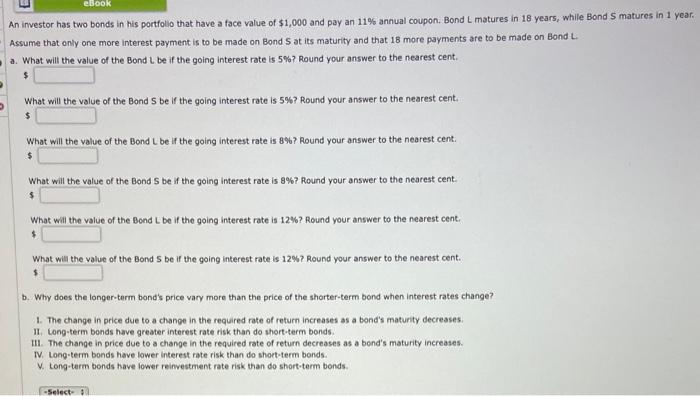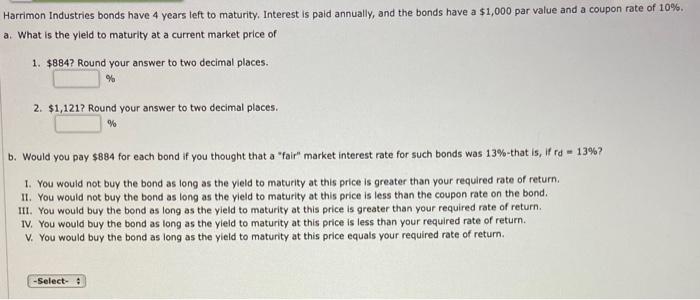An investor has two bonds in his portfolio that have a face value of $1,000 and pay an 11% annual coupon. Bond L matures in 18 years, while Bond 5 matures in 1 year. Assume that oniy one more interest payment is to be made on Bond S at its maturity and that 18 more payments are to be made on Bond L. a. What will the value of the Bond L be if the going interest rate is 5% ? Round your answer to the nearest cent. 5 What will the value of the Bond 5 be if the going interest rate is 5% ? Round your answer to the nearest cent. 5 What will the value of the Bond L be if the going interest rate is 8% ? Round your answer to the nearest cent. 5 What will the value of the Bond S be if the going interest rate is 8% ? Round your answer to the nearest cent. $ What will the value of the Bond L be if the going interest rate is 12% ? Round your answer to the nearest cent. 4 What will the value of the Bond 5 be if the going interest rate is 12% ? Round your answer to the nearest cent. 5 b. Why does the longer-term bond's price vary more than the price of the shorter-term bond when interest rates change? 1. The change in price due to a change in the required rate of return increases as a bond's maturity decreases. II. Long-term bonds have greater interest rate risk than do short-term bonds. III. The change in price due to a change in the required rate of return decreases as a bend's maturity increases. TV. Long-term bonds have lower interest rate risk than do short-term bonds. V. Long-term bonds have lower reinvestment rate risk than do short-term bonds. Harrimon Industries bonds have 4 years left to maturity. Interest is paid annually, and the bonds have a $1,000 par value and a coupon rate of 10%. a. What is the yleid to maturity at a current market price of 1. $884? Round your answer to two decimal places. % 2. $1,121 ? Round your answer to two decimal ploces. % b. Would you pay $884 for each bond if you thought that a "fair" market interest rate for such bonds was 13%-that is, if rd = 13% ? 1. You would not buy the bond as long as the yield to maturity at this price is greater than your required rate of return. II. You would not buy the bond as long as the yield to maturity at this price is less than the coupon rate on the bond. III. You would buy the bond as long as the yield to maturity at this price is greater than your required rate of return. IV. You would buy the bond as long as the yield to maturity at this price is less than your required rate of return. V. You would buy the bond as long as the yield to maturity at this price equals your required rate of retum








